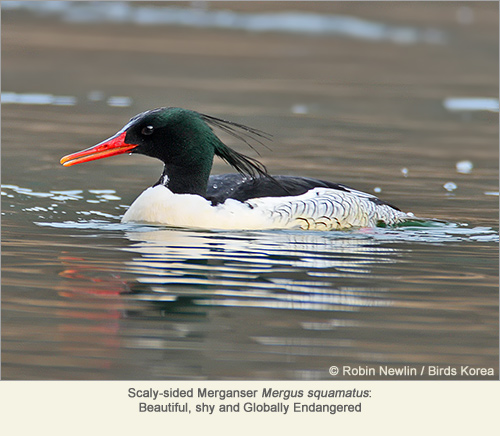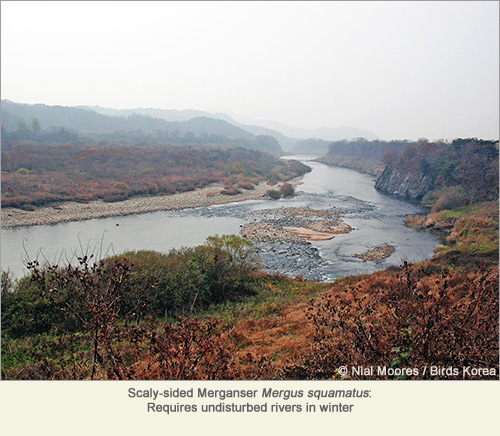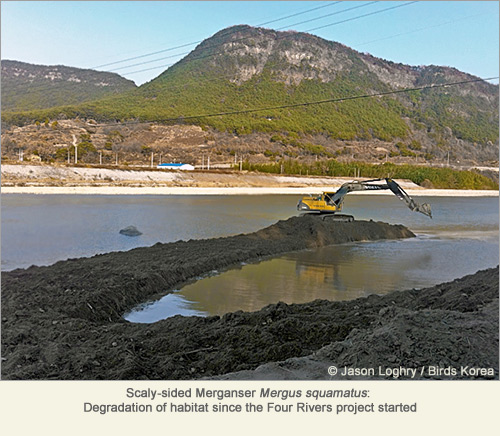The Scaly-sided Merganser Mergus squamatus is a globally Endangered, exquisitely-patterned and typically shy duck. In winter, it is most often found in small flocks on fast-flowing and relatively undisturbed stretches of river. Due to its rarity and its habitat-specialisation, the Scaly-sided Merganser is a flagship species, a living symbol, of East Asian rivers. As such, an international Task Force has been set up by the East Asian-Australasian Flyway Partnership (EAAFP) especially for the conservation of the Scaly-sided Merganser. Birds Korea is the Korean NGO member of this Task Force.
We will therefore conduct focused research on the Scaly-sided Merganser and the rivers it depends on in January 2014. The main survey period will be between January 11th and 18th. We welcome your support and involvement – in fund-raising and fieldwork.
Why “Scalies”?
Why should we or anybody work to conserve the Scaly-sided Merganser? In addition to clear moral and ethical obligations, the survival of the Scaly-sided Merganser depends on the health of rivers and river catchments. Conserving this species therefore requires conserving the best rivers and river catchments – which of course are also vital to the well-being of many other species, including people. Conservation of rivers and of the Scaly-sided Merganser is in our own and in the national interest.
The need for conservation of “Scalies” has therefore already become a priority for the governments of the region, through their support of the EAAFP’s Scaly-sided Merganser Task Force. The need for river and biodiversity conservation is also fully recognised by governments that have joined the Ramsar “Wise Use of Wetlands” Convention and the Convention on Biological Diversity (CBD). CBD, for example, calls on governments to ensure by 2020 that “the conservation status (of threatened species), particularly of those most in decline, (be) improved and sustained” and that “the rate of loss of all natural habitats (be) at least halved and where feasible brought close to zero”. The ROK is an active member of both of these conventions. Our nation hosted the 2008 Ramsar Convention conference and will host the 2014 CBD conference. We need to support our nation’s efforts to fulfil these important conservation obligations.
What kind of work?
Conservation of birds and their habitats always requires getting the best information to the right people at the right time in the right way. Our work for the Scaly-sided Merganser in 2014 will include research, analysis, and information-sharing, aimed towards the next intergovernmental CBD conference, to be held here in the ROK in October 2014.
Already, a small team of Birds Koreans has been making multiple counts of Scalies along one river, at least monthly in 2011 / 2012 and again in the winter of 2013 / 2014. Multiple images of the site have been taken and details recorded. In 2012, Birds Koreans also surveyed more than ten additional rivers nationwide that were suspected to support the species. We counted 140-149 Scalies. This count compares with only 30 found nationwide the same winter by the annual nationwide Winter Bird Census, coordinated by the Ministry of Environment. Our research confirms both that the Scaly-sided Merganser is easy to overlook during general bird surveys, and that several of the rivers that the species depends on are still not regularly surveyed.
Our research this past decade has also confirmed that the species is shy and local, and that its “natural habitat” continues to be disturbed and degraded. As we predicted, the ecologically disastrous Four Rivers project has impacted many sites between 2009 and the present. River-side vegetation has been removed, rivers have been dredged and wide bicycle trails have been constructed causing much disturbance to once quiet rivers. These changes have contributed to declines in many species of waterbird at these sites and nationally. Many of the rivers used by Scaly-sided Mergansers even now, in 2014, are still being converted into “parks”, further reducing their value to biodiversity in general and this species in particular.
In 2014, between January 11th and 18th, three or more teams will therefore again survey all known Scaly-sided Merganser sites nationwide, and survey additional stretches of river that might support the species. This research, and future survey work and analysis, will help us to:
- Improve the national population estimate of the species;
- Identify more of the rivers used regularly by the species;
- Map sites used by the species;
- Determine changes in number of the species through a single winter and between years (e.g. between 2012 and 2014);
- Determine changes to the habitat they use between years;
- Identify causes likely to be driving changes in the number of birds, both by site and at the national level;
How will the results be used?
To ensure that the results reach a wide audience, we will publish them in English and Korean on our websites, and we will pass them on to other members of the international Scaly-sided Merganser Task Force. This includes the national Ministry of Environment. There is some possibility too that the results might also be published as part of a peer-reviewed regional review of the species.
If funding can be found, the results and analysis will then also be included in a special Birds Korea Report, now being written as part of our contribution to the 2014 CBD Conference. This report, as proposed, will provide a national overview of changes in bird populations during the past century. It will include case studies on representative species of key habitat types, and it will highlight the Scaly-sided Merganser and the rivers it depends on.
Please contact us if you have more questions and would like to support this work!
Please Note: All research participation costs for paid-up Birds Korea members will be covered by Birds Korea; non-members are required to cover their own expenses and will be asked to donate a daily participation charge of 100,000 KW, to help support further work for this species.
Birds Korea, now entering its tenth year, continues to depend entirely on our members and supporters.
Thank you for your support of this project.






